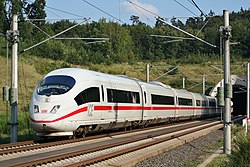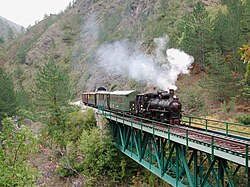Железница
Железница је назив за саобраћајни систем где се возила крећу по стално постављеној металној подлози - челичним шинама. Две шине заједно чине колосек. За разлику од друмског превоза, где се возила крећу по припремљеној равној површини, шинска возила су вођена колосецима којима се крећу. Шине се обично састоје од челичних шина, уграђених на прагове постављене у туцаник, на којима се креће возни парк, обично опремљен металним точковима.




Историја
уредиИсторија железничког саобраћаја почела је у праисторијским временима.
Древни системи
уредиДокази указују на то да је Диолкос поплочана стаза била дуга 6 до 8,5 km, која је превозила чамце преко Коринтске превлаке у Грчкој од око 600. године п. н. е.[1][2][3][4][5] Возила која су вукли људи и животиње кретала су се у жљебовима у кречњаку, који је обезбедио елемент колосека, спречавајући вагоне да напусте предвиђену трасу. Диолкос је био у употреби преко 650 година, најмање до 1. века нове ере.[5] Поплочане стазе су такође касније изграђене у римском Египту.[6]
Железничка возила
уредиВозна средства у систему железничког транспорта углавном наилазе на мањи отпор трења у односу на друмска возила са гуменим точковима, те се путнички и теретни вагони могу спајати у дуже возове. Погон за кретање обезбеђују локомотиве,[7] које или црпе електричну енергију из система за електрификацију железнице или производе сопствену снагу, обично дизел моторима или, историјски гледано, парним машинама. Већину колосека прати систем сигнализације.
Железнички саобраћај
уредиЖелезнички саобраћај је врста транспорта где се превоз робе или путника врши вагонима који се крећу по прузи уз локомотивску вучу. Превоз на јавним пругама организује железничко предузеће, које обезбеђује превоз између железничких станица или корисника из привреде. Железнице су сигуран систем копненог превоза у поређењу са другим облицима превоза.[Nb 1] Железнички превоз је способан за остваривање високог нивоа путничког и теретног искоришћења и енергетске ефикасности, али је често мање флексибилан и капитално интензивнији од друмског превоза, када се разматрају нижи нивои саобраћаја.
Основне карактеристике железничког саобраћаја
уредиОсновне карактеристике железничког саобраћаја су:
- Позитивне
- висока пропусна и превозна способност
- превоз независно од климатских услова
- непосредна веза магистралних и пратећих колосека
- масовност превоза
- Негативне
- ограничен маневар
- велика почетна улагања[8]
Развој железница
уредиПрви вагончићи на пругама употребљавали су се још у 16. веку у Немачкој и Енглеској за превоз ископане руде. Вагончиће су вукли коњи. У градовима коњи су вукли вагоне железницом и тако превозили нижу класу.[9]
Енглески инжењер Џорџ Стивенсон изумео је прву парну локомотиву. Могла је брзином пешака вући неколико рудничких вагона. Градњом удобнијих вагона, почео је теретни и путнички развој железница.
Прва јавна железничка веза успостављена је 1825. између енглеских градова Стоктона и Дарлингтона.
После споре парне железнице настале су дизелске, па модерне електричне железнице.
Железница се састоји од инфраструктуре (шине), локомотиве, вагони (путнички и или теретни) и других помоћних објеката.
Види још
уредиНапомене
уреди- ^ According to [Bradbury, Norman (новембар 2002). Face the facts on transport safety (PDF). Railwatch (Извештај). Архивирано из оригинала (PDF) 11. 10. 2010. г.], railways are the safest on both a per-mile and per-hour basis, whereas air transport is safe only on a per-mile basis.
Референце
уреди- ^ Verdelis, Nikolaos (1957). „Isthme, Corinthie, Argolide”. Bulletin de Correspondance Hellénique. 81: 526—529. doi:10.3406/bch.1957.2388. (526)
- ^ Cook, R. M. (1979). „Archaic Greek Trade: Three Conjectures”. The Journal of Hellenic Studies. 99: 152—155. JSTOR 630641. S2CID 161378605. doi:10.2307/630641.
- ^ Drijvers, Jan Willem (1992). „Strabo VIII 2,1 (C335): ΠΟΡΘΜΕΙΑ and the "Diolkos"”. Mnemosyne. 45 (1): 75—78. JSTOR 4432110.
- ^ Raepsaet, Georges (1993). „Le diolkos de l'Isthme à Corinthe : Son tracé, son fonctionnement , avec une annexe, Considérations techniques et mécaniques”. Bulletin de Correspondance Hellénique. 117: 233—261. doi:10.3406/bch.1993.1679. (256)
- ^ а б Lewis & Rees 2001, стр. 8–19
- ^ Fraser, P. M. (децембар 1961). „The ΔΙΟΛΚΟΣ of Alexandria”. The Journal of Egyptian Archaeology. 47: 134—138. JSTOR 3855873. doi:10.2307/3855873.
- ^ Fowler, George Little (1906). Locomotive dictionary; an illustrated vocabulary of terms which designate American Railroad locomotives, their parts, attachments and details of construction, with definitions and illustrations of typical British locomotive practice; five thousand one hundred and forty-eight illustrations (PDF). New York: The Railroad Gazette.
- ^ Транспортне способности - капацитет транспорта
- ^ „Зашто и како смо коње заменили аутомобилима?”. Стартит. јун 2016. Приступљено 17. 01. 2019.
Литература
уреди- Lewis, M. J. T. (2001). „Railways in the Greek and Roman world” (PDF). Ур.: Guy, A.; Rees, J. Early Railways. A Selection of Papers from the First International Early Railways Conference. стр. 8—19. Архивирано из оригинала (PDF) 21. 7. 2011. г.
- Burton, Anthony (2018). Railway Empire: How the British Gave Railways to the World. Pen & Sword Transport. ISBN 978-1473843691.
- Chant, Christopher (2001). The world's railways: the history and development of rail transport. Chartwell Books..
- Faith, Nicholas (25. 9. 2014). The World the Railways Made: Christian Wolmar's Railway Library. Head of Zeus. ISBN 978-1781858363.
- Freeman, Michael (1999). „The Railway as Cultural Metaphor: ‘What Kind of Railway History?’ Revisited.”. Journal of Transport History. 20 (2): 160—167..
- Mukhopadhyay, Aparajita (2018). Imperial Technology and ‘Native’Agency: A Social History of Railways in Colonial India, 1850–1920. Taylor & Francis..
- Nock, O. S. (1966). Steam railways in retrospect.
- Nock, Oswald Stevens (1970). Railways at the zenith of steam, 1920-40. Blandford. ISBN 9780713705157.
- Nock, Oswald Stevens (1971). Railways in the years of preeminence 1905-1919. Blandford Press. ISBN 9780713700817.
- Nock, Oswald Stevens (1973). Railways in the formative years, 1851-1895. Blandford Press. ISBN 9780713706123.
- Nock, O. S. (1974). Railways in the transition from steam, 1940-1965. New York: Macmillan. ISBN 9780025897502.
- Nock, Oswald Stevens (1975). Railways then and now: a world history. ISBN 9780236310524.
- Nock, O. S. (1977). Railways of Western Europe. ISBN 9780713616866.
- Nock, O. S (1978). Railways of Asia and the Far East.
- Nock, O. S. World atlas of railways. Nock, Oswald Stevens (1978). World atlas of railways. Mayflower Books. ISBN 9780831795009.
- Nock, Oswald Stevens (1979). Railways of the USA. Black. ISBN 9780713620061.
- Nock, Oswald Stevens (1980). 150 years of main line railways. David & Charles. ISBN 9780715378816.
- Pirie, Gordon (2014). „Tracking railway histories.”. Journal of Transport History. 35 (2): 242—248..
- Sawai, Minoru, ed (2017). The Development of Railway Technology in East Asia in Comparative Perspective. #Sringer.
- Trains Magazine (2014). The Historical Guide to North American Railroads (3rd изд.).
- Wolmar, Christian (2011). Blood, iron, and gold: How the railroads transformed the world. Public Affairs..
- Cameron, Rondo E. (1961). France and the Economic Development of Europe, 1800–1914: Conquests of Peace and Seeds of War. стр. 304–227.covers France, Spain Russia and others.
- Churella, Albert J. (1998). From Steam to Diesel: Managerial Customs and Organizational Capabilities in the Twentieth-Century American Locomotive Industry. Princeton, New Jersey: Princeton University Press. ISBN 978-0-691-02776-0.
- Coatsworth, John H. (1979). „Indispensable Railroads in a Backward Economy: The Case of Mexico”. The Journal of Economic History. 39 (4): 939—960. JSTOR 2120337. S2CID 153803795. doi:10.1017/S0022050700098685.
- Fraser, P. M. (1961), „The ΔΙΟΛΚΟΣ of Alexandria”, The Journal of Egyptian Archaeology, 47: 134—138, JSTOR 3855873, doi:10.2307/3855873
- Fremdling, Rainer (1977). „Railroads and German Economic Growth: A Leading Sector Analysis with a Comparison to the United States and Great Britain”. The Journal of Economic History. 37 (3): 583—604. JSTOR 2119597. S2CID 155002570. doi:10.1017/S0022050700095395.
- Hadfield, C. and Skempton, A. W. William Jessop, Engineer (Newton Abbot 1979)
- Jenks, Leland H. (1944). „Railroads as an Economic Force in American Development”. The Journal of Economic History. 4 (1): 1—20. JSTOR 2113700. S2CID 154883188. doi:10.1017/S002205070008400X.
- Keys, C. M. (август 1914). „Redrawing The Railroad Map of the World”. The World's Work: A History of Our Time. XLIV (2): 414—425. Includes maps of major rail lines on all continents c. 1914
- Lewis, M J T (1970). „Early Wooden Railways”. London, England: Routledge Keegan Paul..
- Lewis, M. J. T., "Railways in the Greek and Roman world", in Guy, A. / Rees, J. (eds), Early Railways. A Selection of Papers from the First International Early Railways Conference (2001), pp. 8–19 (10–15)
- Misa, Thomas J. (1995). A Nation of Steel: The Making of Modern America, 1865–1925. chapter 1 'Dominance of Rails' online
- New, J R. (2004). „400 years of English railways – Huntingdon Beaumont and the early years”. Backtrack. 18 (11 (Nov)): 660 to 665..
- Nock, O. S. ed. Encyclopedia of Railways (London, 1977), worldwide coverage, heavily illustrated
- O’Brien, Patrick. Railways and the Economic Development of Western Europe, 1830–1914 (1983)
- O'Brien, Patrick. The New Economic History of the Railways (Routledge, 2014)
- Omrani, Bijan (2010). Asia Overland: Tales of Travel on the Trans-Siberian & Silk Road. Odyssey. ISBN 9789622178113.
- Otte, Thomas G. and Keith Neilson, eds (2012). Railways and International Politics: Paths of Empire, 1848–1945. Routledge. 11 essays by leading scholars
- Pinkepank, Jerry A. (1973). The Second Diesel Spotter's Guide. Milwaukee WI: Kalmbach Books. ISBN 978-0-89024-026-7.
- Riley, C. J (2002). The Encyclopedia of Trains & Locomotives..
- Savage, Christopher and T. C. Barker. Economic History of Transport in Britain (Routledge, 2012)
- Schivelbusch, Wolfgang (2014). The railway journey: the industrialization of time and space in the nineteenth century. University of California Press.
- Skelton, Oscar D. (1916). The Railway Builders. Glasgow, Brook, & Company, Toronto.
- Stover, John. American Railways (2nd ed 1997)
- Clarke, Thomas Curtis (јун 1888). „The Building of a Railway”. Scribner's Magazine. III (6): 642—670. Includes numerous c. 1880 diagrams and illustrations.
- Jack Simmons and Gordon Biddle (editors). The Oxford Companion to British Railway History: From 1603 to the 1990s (2nd ed 1999)
- Stover, John (2001). The Routledge Historical Atlas of the American Railroads.
- Summerhill, William R. (2005). „Big Social Savings in a Small Laggard Economy: Railroad-Led Growth in Brazil”. The Journal of Economic History. 65 (1): 72—102. JSTOR 3875043. S2CID 154439121. doi:10.1017/S0022050705050035.
- Hurd II, John and Ian J. Kerr, eds. India's railway history: a research handbook (Brill, 2012)
- Lee, Robert (2013). „A Fractious Federation: Patterns in Australian Railway Historiography.”. Mobility in History. 4 (1): 149—158..
- McDonald, Kate (2015). „Asymmetrical Integration: Lessons from a Railway Empire.”. Technology and Culture. 56 (1): 115—149..
- Pathak, Dev N (2012). „Marian Aguiar, Tracking Modernity: India’s Railway and the Culture of Mobility.”. South Asia: Journal of South Asian Studies. 35 (4): 900—901..
- Salerno, Elena (2014). „The Historiography of Railways in Argentina: Between Foreign Investment, Nationalism and Liberalism.”. Mobility in History. 5 (1): 105—120..
- Broggie, Michael (2014), Walt Disney's Railroad Story: The Small-Scale Fascination That Led to a Full-Scale Kingdom (4th изд.), The Donning Company Publishers, ISBN 978-1-57864-914-3
- C. E. Wolff, Modern Locomotive Practice: A Treatise on the Design, Construction, and Working of Steam Locomotives (Manchester, England, 1903)
- Henry Greenly, (1905). Model Locomotive. New York.
- G. R. Henderson, Cost of Locomotive Operation (New York, 1906)
- W. E. Dalby, Economical Working of Locomotives (London, 1906)
- A. I. Taylor, Modern British Locomotives (New York, 1907)
- E. L. Ahrons, The Development of British Locomotive Design (London, 1914)
- Ahrons, Ernest Leopold (1921). Steam Locomotive Construction and Maintenance, Describing Workshop Equipment and Practice in the Construction of Modern Steam Railway Locomotives: With Notes on Inspection, Testing, Maintenance and Repairs. London.
- J. F. Gairns, Locomotive Compounding and Superheating (Philadelphia, 1907)
- Angus Sinclair, (1907). Development of the Locomotive Engine. New York.
- Vaughn Pendred, (1908). The Railway Locomotive, What it is and Why it is What it is. London.
- Brosius and Koch, Die Schule des Lokomotivführers (thirteenth edition, three volumes, Wiesbaden, 1909–1914)
- G. L. Fowler, Locomotive Breakdowns, Emergencies, and their Remedies (seventh edition, New York, 1911)
Додатна литература
уреди- McArthur, D. (1884). Foreign Railways of the World.
Спољашње везе
уреди- Железнице Србије
- Планирање путовања железницом (језик: енглески)
- WWW Guide to "Railroad History" 2016
- John H. White, Jr. Reference Collection, 1880s–1990 Архивирано на сајту Wayback Machine (5. август 2015) Archives Center, National Museum of American History, Smithsonian Institution.
- National Railway Historical Society Архивирано на сајту Wayback Machine (18. април 2019)
- How the Railroad is Modernising Asia, The Advertiser, Adelaide, S. Australia, 22 March 1913. N.B.: The article is approx. 1,500 words, covering approx. a dozen Asian countries.